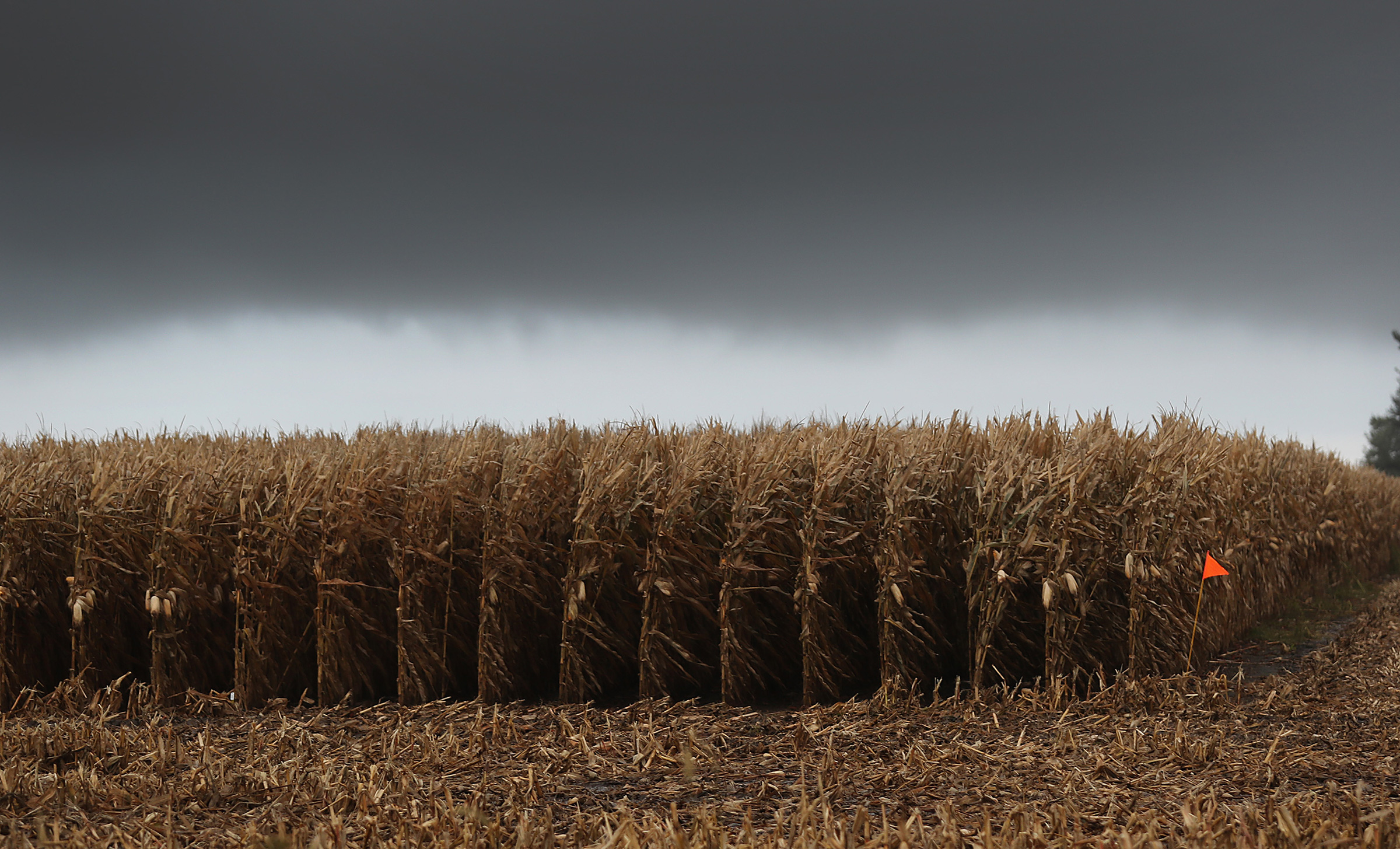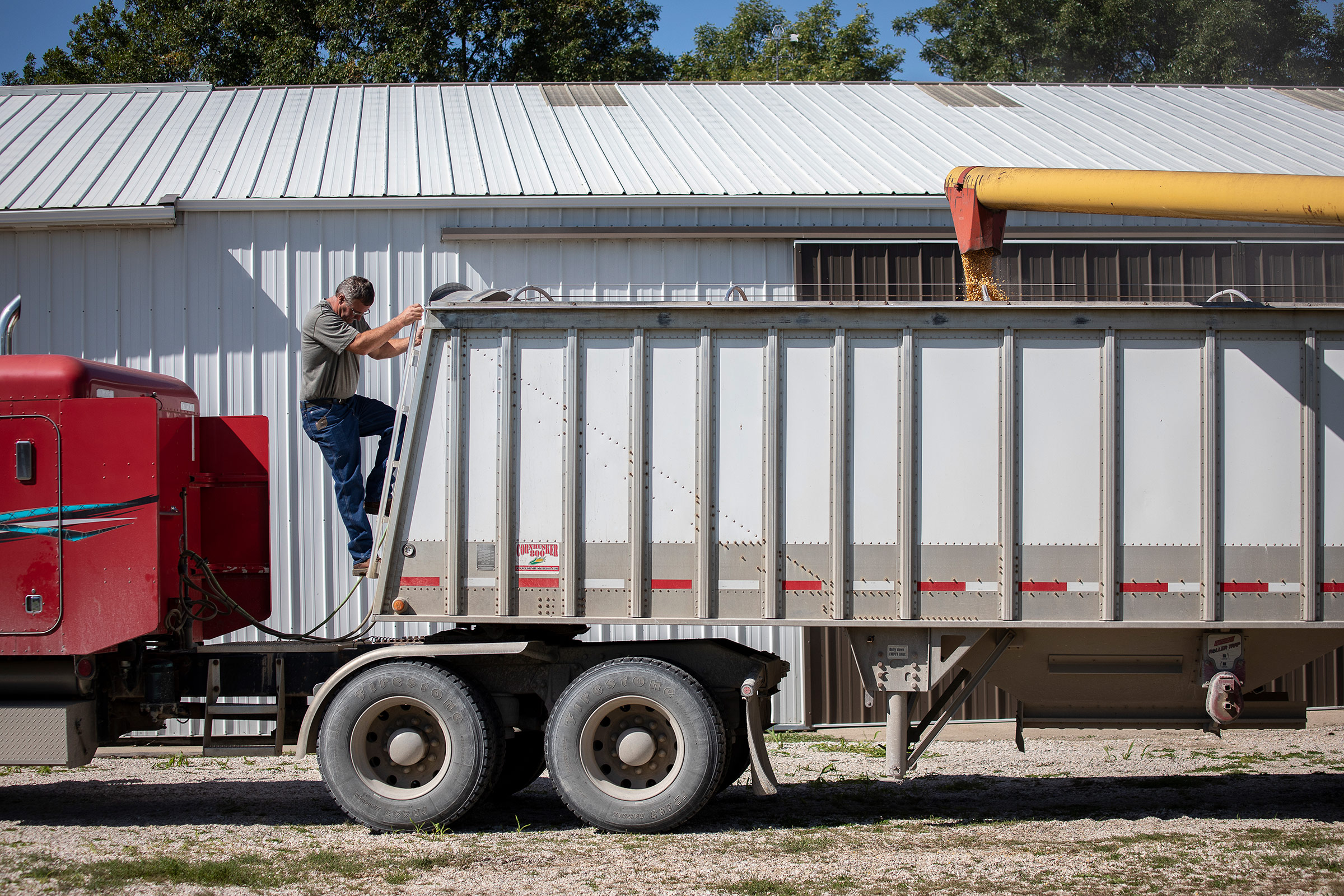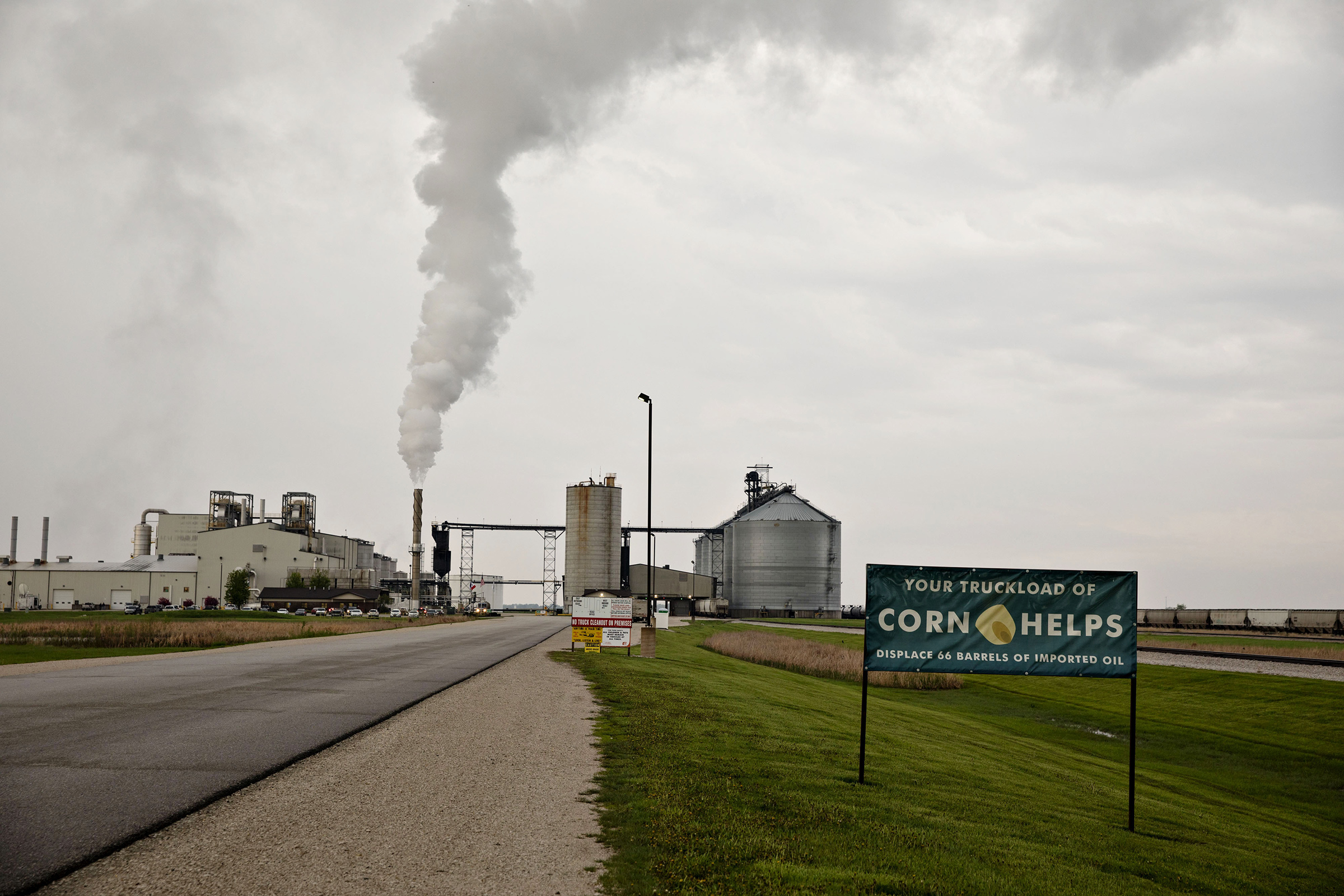Persuading Iowa farmers to let workers dig a 1,300-mile liquified carbon dioxide pipeline network through their land was never going to be easy, but executives from Navigator CO2 Ventures gave it their best shot. Ethanol refineries in the state release tens of millions of tons of CO2 into the atmosphere every year as they ferment corn into fuel, and Navigator had seen a business opportunity in capturing those emissions and burying them underground hundreds of miles away in Illinois. But before they could build the project, they had to try to get locals on board.
Navigator executives laid out their arguments at a Jan. 19 Iowa Utilities Board public meeting. The company’s Heartland Greenway—one of a slew of CO2 pipeline proposals in Iowa—would be an investment in the state’s agricultural future, the representatives said. It would also cut the corn-ethanol sector’s CO2 emissions by roughly 15 million tons, according to their internal estimates, the equivalent of taking 3.2 million cars off the road. Plus, Navigator C02 Ventures—which shares much the same management and ownership (including private equity giant BlackRock) as Navigator Energy Services, a Dallas-based oil pipeline company—had a deep respect for rural Americans. “I, too, am an Iowan,” said Elizabeth Burns-Thompson, Navigator’s VP of government and public affairs, at the meeting. “I grew up on my family’s farm and have worked in agriculture all my professional life.”
A tidal wave of questions from attendees followed. Was there a full carbon budget for the project? (Navigator: no.) Could the pipeline burst? (Not likely.) Would the state use force to take farmers’ land? (Iowa officials: We’ll circle back on that.) Many attendees used their allotted three minutes just to say their piece. “I want everyone to know that, basically, this company is here to line their pockets with our land,” said one landowner. At some points during the four-hour question period, undiluted rage burst into view. “Ms. Burns-Thompson,” said an attendee, “you ought to be ashamed of yourself, representing yourself as a local Iowa farm girl and sitting on that side of the desk.”
Similar scenes might soon play out across the country. In Washington, D.C., politicians from both parties have gotten behind projects like Navigator’s, envisioning a national network of pipelines to transport CO2 from power plants and industrial emitters to geologic formations where it can be stored. Investment firms, fossil fuel companies, and agribusiness are all in support, and in the recently passed infrastructure bill, legislators set aside $100 million for the Energy Department to design carbon pipeline systems, plus $2.1 billion in loans and grants to fund building the pipelines over the next five years, while tax codes have carved out huge incentives for developers to build those projects. Iowa, along with much of the rest of the agricultural Midwest, has become a test case for these kinds of projects, with pipeline projects to transport emissions from the region’s ethanol refineries nearing final approval. But as those first large-scale projects are getting underway, growing outrage from locals has threatened to derail well-laid plans, creating what amounts to a litmus test for the possibility of building a coast-to-coast web of CO2 pipelines.

Last year, the largest corn crop of any U.S. state was grown across about 20,000 square miles of land in Iowa, an area of planted fields about the size of Vermont and Maryland combined. Half of it went to livestock feed, was processed into products like corn syrup, or was used in various industrial processes. The other half was trucked to biorefineries, fermented into ethanol, and mixed with gasoline at the pump (most gasoline sold in the U.S. is about 10% ethanol). That would seem to be a good story for the global climate. Fermenting corn into ethanol releases CO2, as does burning ethanol in a car engine, but those are the same carbon molecules that the corn pulled out of the atmosphere as it was growing, meaning no net carbon was added to the atmosphere. But the rest of the process—shipping in seed, producing fertilizer, harvesting the corn, and trucking huge quantities of grain to processing facilities—produces a lot of emissions, leaving ethanol with a carbon footprint similar to that of gasoline.
In February 2018, the federal government increased a tax credit for companies that permanently stored CO2 underground, and the move got the attention of players in the ethanol world. Previous projects to capture carbon from sources like coal power plants have exceeded costs and underperformed—but applying the technology to ethanol plants would be a simpler prospect. Coal plant emissions are only about 13% CO2—the rest being mostly oxygen and nitrogen, plus pollutant gases like SO2, NOx, and a lot of fine particulates (think smog)—and separating out the CO2 takes a lot of work. Ethanol refineries, on the other hand, emit almost pure CO2, so the process to capture it would be far cheaper, and ethanol plants that took advantage of the new credit could make a tidy profit.
However, capturing the emissions is only the first part—you also have to put them somewhere. Typically, that means finding special geologic formations where you can pump the CO2 underground and it won’t come back up. Iowa doesn’t have much of that. But North Dakota and Illinois, hundreds of miles from Iowa’s corn fields, both have plenty.
In February 2021, an Alden, Iowa-based agricultural conglomerate called Summit Agricultural Group proposed a project to span that geographic divide. They would install equipment to collect emissions at 31 ethanol plants throughout Iowa and neighboring states, liquify the gas and then transport it in a new 2,000-mile pressurized pipeline to North Dakota, where it would be injected underground. Other companies unveiled similar proposals, including Navigator, which announced its own CO2 pipeline project from Iowa to storage sites in Illinois in March.
The proposals looked like they would sail by state regulators. After all, Iowa’s Republican Governor Kim Reynolds was a supporter of ethanol and carbon pipelines, and her predecessor, Terry Branstad had, after three years as President Donald Trump’s ambassador to China, become a policy advisor at Summit in March 2021. The public check on Navigator and Summit’s ambitions is meant to be the Iowa Utility Board (IUB), a three-member council with the authority to approve or deny pipeline proposals, and to decide if companies can use eminent domain to get control of private land they need to build through. But in spring 2021, the board was stacked: two members had been appointed by Branstad during his 2011-2017 stint in the governorship, and the third seat had recently been filled by a hand-picked Reynolds appointee.

In some sense, the state needed these pipelines. Ethanol had been a booming business in Iowa for years, with production quadrupling between 2004 and 2018 thanks to U.S. Environmental Protection Agency mandates to replace gradually increasing amounts of U.S. gasoline with biofuels. But with electric vehicles taking off and the Biden Administration pursuing electric charging infrastructure, Iowan politicians worried ethanol’s days could be numbered, which could be a big problem for the state’s corn-growing industry. CO2 pipeline projects could, in theory, help make ethanol remain relevant in a green-energy future.
“The alternative to that is that ethanol doesn’t evolve, and it doesn’t have the opportunity to compete as greatly with electric vehicles from a carbon footprint perspective,” says Justin Kirchhoff, president of Summit Ag Investors, a division of Summit Agricultural Group.
Local environmental activists are skeptical that Summit and Navigator will be able to store as much CO2 as they say they can—they point to studies showing that past carbon capture projects were relatively ineffective in reducing emissions when the carbon cost of actually running the necessary equipment was taken into account. Some experts think that’s an unfair comparison since the CO2 coming out of ethanol plants is so much more concentrated than in those other projects, and they cite potentially huge emissions benefits—Navigator’s project, for instance, could reduce Iowa’s annual CO2 emissions by 5% to 8%.
Even if that is the case, many environmentalists argue that the federal government should be eliminating corn fuel altogether rather than paying billions of dollars to decarbonize it. Ethanol isn’t energy-dense enough to power sectors like aviation and shipping, and environmentalists see attempts to keep it in the energy mix as a strategy to delay phasing out gasoline cars and prop up an uneconomical, ecologically costly corn ethanol industry. “We’re really just seeing big businesses working together to keep these industries that are on their deathbeds alive,” says Emma Schmit, an Iowa-based organizer at Food & Water Watch, a non-governmental organization. “People on the ground see it for what it is: a lie.”
After the projects were announced, Iowa’s Sierra Club chapter and other environmental groups started sending out flyers and published letters in local papers, asking Iowa landowners to reach out if the pipeline companies contacted them. They organized weekly meetings starting in October 2021 to discuss group actions, like jointly declaring they wouldn’t sign agreements to let pipeline developers use their property, and later brought in lawyers to talk about a joint legal fight. “It started out small,” says Jess Mazour, conservation coordinator for Iowa’s Sierra Club chapter, speaking in late January. “There were about 10 of us, then there were 20, and it grew and grew every single week. Now there’s more than 700 people in our group who are refusing to sign easements, and it grows more every single day.”

In large part, the opposition to new CO2 pipelines comes down to economics, and property rights. Deborah Main, 72, who owns a 195-acre farm northeast of Sioux City, found out that Summit wanted to build across her land late last summer. “My first reaction was that this project is ludicrous,” she says. “They are taking my land and filling their pockets with government money.” (She’s also concerned about a potential pipeline rupture and thinks the pipeline will be bad for the global climate.) Main joined a landowner group hosted by the Sierra Club, and decided that she would refuse to sign an easement along with hundreds of other Iowans. Many farmers have heard stories about farmland damaged by previous pipeline incursions, for which landowners had never been fairly compensated. “Everyone’s concerned about this,” says Richard McKean, a retired farmer who owns land in the path of the Navigator pipeline. “Our land is our livelihood.”
Towards the end of last year, with hostility rising in public forums, anti-pipeline lawn signs sprouting up around the state, and individual objections piling up in the IUB’s electronic filing system, Navigator and Summit brought out the big guns. In mid-December, a letter from Terry Branstad arrived in mailboxes of those in the pipeline’s path. “If the Sierra Club gets its way, there will be nothing left of Iowa’s ethanol industry,” the former governor wrote on Summit letterhead. “They are not your friends and will be long gone after they have destroyed the ethanol industry and the value of your corn-producing land.” Days later, he was on local Iowa news, making the case that Iowa farmers needed the CO2 pipeline to remain competitive in an energy-transition future.
As controversy over the pipelines spread, the usual political lines have blurred. Some of those opposing the pipelines have long been sympathetic to groups like the Sierra Club. Others, like those in the state’s largely conservative farming community, were less-likely allies, but found common cause opposing projects they felt would damage their land for private gain. The Republican party controls both houses of the legislature and the governorship in Iowa, but pipeline opposition has split the caucus. Tom Jeneary, a Republican representative in the Iowa House, says he’s been contacted by more than 150 constituents asking him not to let the pipelines go forward. “When you have that many people in the district that you are privileged to represent saying, ‘Please don’t do this,’” Jeneary says, “I don’t do it.” He supported a bill (ultimately defeated in committee on Feb. 17) that would have limited pipeline companies’ ability to seize control of farmers’ land. If the IUB pushes forward with pipelines despite landowner opposition, Jeneary says there’s likely enough support in the legislature to call a special session to block the approvals. Then it would be up to Governor Reynolds to sign or veto the legislation.
For now, pipeline progress has continued, despite anger in public meetings. Summit submitted its permit application to the IUB on Jan. 28, and Navigator is expected to file its own request in the coming weeks. And Iowans who live in the path of those projects continue to see signs of their momentum. Late last month, Deborah Main was coming home from church when she spotted surveyors from Summit parked a quarter mile north of her house. They promised not to come on her land, and for days Main kept an eye on them to make sure they kept their word. Still, seeing them out on the road made her anxious. When they finally left, Main knew her relief would likely be temporary—under Iowa law, a certified letter and 10-days’ notice was all Summit needed to force her to let surveyors on her farm. “I feel this letter is coming any day,” Main says, “and I’m going to have to unlock my gate, and let them in.”
There’s reason for some observers in the climate world to be uneasy as well. Carbon capture for ethanol is controversial, but there is a growing consensus that some of it will be necessary in sectors like steel and cement for the world to draw down emissions and avoid catastrophic warming. That means that some people, somewhere, will have to let CO2 pipelines through their land. In Iowa, though, some key environmental campaigners say it won’t happen in their state. “We’re closing the doors,” says Mazour, of the Sierra Club. “We don’t want them here.”
- The 100 Most Influential People of 2024
- The Revolution of Yulia Navalnaya
- 6 Compliments That Land Every Time
- What's the Deal With the Bitcoin Halving?
- If You're Dating Right Now, You're Brave: Column
- The AI That Could Heal a Divided Internet
- Fallout Is a Brilliant Model for the Future of Video Game Adaptations
- Want Weekly Recs on What to Watch, Read, and More? Sign Up for Worth Your Time



